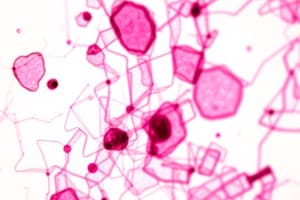Podcast
Questions and Answers
What is the principle behind colorimetric analysis?
What is the principle behind colorimetric analysis?
- Many substances in solution can be colored or produce a colored derivative (correct)
- The Beer-Lambert law states that the amount of light absorbed by a colored solution is directly proportional to the concentration of the solution and the length of the light path through it
- The Walden Precision Apparatus (WPA) CO700D medical colorimeter has a light source, filters, photosensitive detector system, and cells (cuvettes) to hold solutions
- Colored substances absorb light at specific wavelengths in the visible spectrum
What is the Beer-Lambert law?
What is the Beer-Lambert law?
- The amount of light absorbed by a colored solution is directly proportional to the concentration of the solution and the length of the light path through it (correct)
- The visible light spectrum ranges from about 400 nm to 700 nm
- The Walden Precision Apparatus (WPA) CO700D medical colorimeter has a light source, filters, photosensitive detector system, and cells (cuvettes) to hold solutions
- Colored substances absorb light at specific wavelengths in the visible spectrum
What is the difference between colorimeters and spectrophotometers?
What is the difference between colorimeters and spectrophotometers?
- Colorimeters and spectrophotometers both use colored filters to cover wavelength ranges
- Colorimeters and spectrophotometers are the same thing
- Colorimeters use a diffraction grating or prism to disperse white light into a continuous spectrum and spectrophotometers use colored filters to cover wavelength ranges
- Colorimeters use colored filters to cover wavelength ranges and spectrophotometers use a diffraction grating or prism to disperse white light into a continuous spectrum (correct)
What is the primary cause of overweight and obesity?
What is the primary cause of overweight and obesity?
What is the most widely used measurement for abdominal fat distribution?
What is the most widely used measurement for abdominal fat distribution?
What is the recommended duration for completing weight loss through physical activity?
What is the recommended duration for completing weight loss through physical activity?
Which of the following is NOT a health benefit of weight loss?
Which of the following is NOT a health benefit of weight loss?
What is the risk factor for insulin resistance, diabetes mellitus, and cardiovascular disease in terms of waist circumference?
What is the risk factor for insulin resistance, diabetes mellitus, and cardiovascular disease in terms of waist circumference?
What is the primary cause of overweight and obesity?
What is the primary cause of overweight and obesity?
Which of the following is a risk factor for insulin resistance, diabetes mellitus, and cardiovascular disease?
Which of the following is a risk factor for insulin resistance, diabetes mellitus, and cardiovascular disease?
What is the recommended duration of physical activity per week for weight loss?
What is the recommended duration of physical activity per week for weight loss?
Which of the following is NOT a health benefit of weight loss?
Which of the following is NOT a health benefit of weight loss?
What is the recommended treatment for weight loss in patients with BM > 35 Kg/m2 and severe comorbidities?
What is the recommended treatment for weight loss in patients with BM > 35 Kg/m2 and severe comorbidities?
Flashcards are hidden until you start studying
Study Notes
Principles of Colorimetric Analysis
- Colorimetric analysis is based on the principle that many substances in solution can be colored or produce a colored derivative.
- The intensity of color in a solution is related to the amount of substance present, with higher concentrations appearing darker in color.
- Colored substances absorb light at specific wavelengths in the visible spectrum, with pale colored solutions absorbing only a small amount of light and dark colored solutions absorbing a lot of light.
- The visible light spectrum ranges from about 400 nm to 700 nm, with wavelengths shorter than 400 nm being ultraviolet and longer than 700 nm being infrared.
- A substance's ability to selectively absorb certain wavelengths of light is determined by its molecular and atomic structures.
- The Beer-Lambert law states that the amount of light absorbed by a colored solution is directly proportional to the concentration of the solution and the length of the light path through it.
- Colorimetric tests use the Beer-Lambert law to determine the concentration of a substance in an unknown solution by comparing it to a standard.
- The amount of light absorbed (optical density or OD) is dependent on the light path distance and wavelength used.
- Colorimeters and spectrophotometers are used to measure absorbance, with colorimeters using colored filters to cover wavelength ranges and spectrophotometers using a diffraction grating or prism to disperse white light into a continuous spectrum.
- The Walden Precision Apparatus (WPA) CO700D medical colorimeter has a light source, filters, photosensitive detector system, and cells (cuvettes) to hold solutions.
- To ensure accurate results, solutions used in colorimetric tests must be homogenous, the substance being measured should not react with the solvent, and a reagent blank must be used to correct for any absorption of light by solvents.
- The Beer-Lambert law can be applied to most clinical chemistry quantitative tests, as long as reliable chemicals and good technique are used to prepare solutions.
Studying That Suits You
Use AI to generate personalized quizzes and flashcards to suit your learning preferences.




